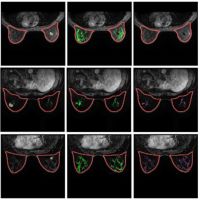When breast cancer is identified during its initial stages, the survival rate is almost perfect, reaching nearly 100 percent. However, for tumours that are discovered in the more advanced stages, this rate drops to approximately 25 percent.
MIT researchers have designed a wearable ultrasound device to allow people to detect tumors whilst they are still in early stages. It is hoped this device can improve the overall survival percentage among individuals diagnosed with breast cancer.
This device could hold significant value for individuals who have a heightened risk of developing breast cancer in the periods between regular mammogram screenings.
The device takes the form of a flexible patch, which can be attached to a bra, enabling the wearer to glide an ultrasound tracker across the patch and capture images of the breast tissue from various angles.
The device allows the user to perform imaging at any time. It relies on the same ultrasound technology employed in medical imaging facilities. However, it integrates an innovative piezoelectric material that allows the researchers to shrink the size of the ultrasound scanner.
Canan Dagdeviren, an associate professor in MIT’s Media Lab and the senior author of the study, said, “It’s portable and easy to use, and provides real-time, user-friendly monitoring of breast tissue”.
Breast tumours that emerge between regularly planned mammograms, referred to as interval cancers, make up approximately 20 to 30 percent of all breast cancer instances. These tumours typically display a greater level of aggressiveness compared to those found during routine scans.
Th goal is to target people who have a higher likelihood of developing interval cancer. By implementing more frequent screening, it is hoped that the survival rate can increase.
Catherine Ricciardi, nurse director at MIT’s Center for Clinical and Translational Research and an author of the study, said, “This technology holds the promise of breaking down the many barriers for early breast cancer detection by providing a more reliable, comfortable, and less intimidating diagnostic”.
Overall, the wearable ultrasound patch is reusable, and there is the potential that it could be used at home by individuals who are at high risk for breast cancer and could benefit from frequent screening. Furthermore, it could aid in diagnosing cancer for individuals who lack regular opportunities for screening.
Source: MIT
Image Credit: MIT



























